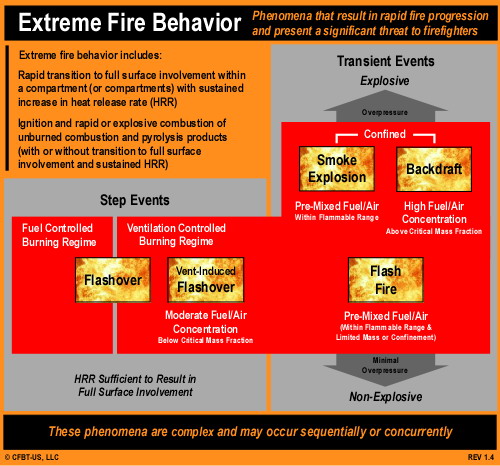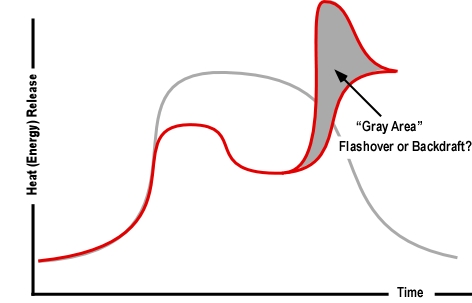Recent Extreme Fire Behavior
Two recent events in Baltimore, Maryland and Gary, Indiana point to the criticality of recognizing key fire behavior indicators and understanding practical fire dynamics.
Five Firefighters Injured in Baltimore
Early on the morning of Friday, January 15, 2010, the Baltimore City Fire Department was dispatched to a residential fire Southeast Baltimore. First arriving companies observed a row house of ordinary construction with a large volume of smoke and flames issuing from the basement and extending to the first floor.
According to a department spokesperson, the first engine took a line through the front door to the rear kitchen area where crew had some trouble finding the basement stairs. Another engine company went to the rear with a line to the outside stairwell leading to the basement and was just starting down the stairs. The first truck vented some skylights on the roof as well as the front basement windows. As crews were attempting to access the fire, some type of transient extreme fire behavior resulted in flames blowing through the unit and out the front door, rear stairwell, second floor windows, and skylights. The firefighter from the first arriving truck assigned to the roof described the sound of a freight train coming through.
Five firefighters injured as a result of this explosive fire behavior phenomenon were transported to area hospitals. The officer of the first in engine company was admitted to the Bayview Burn Center, where he is listed in stable condition
Find more videos like this on firevideo.net
What Happened?
As always when a video of an incident involving extreme fire behavior is posted to the web, there is ongoing debate about what happened. Was it a backdraft? Was it a flashover? An interesting debate, but the value is not so much in being “right”, but in understanding how these phenomena occur, what might have happened in this incident, key indicators that may (or may not) be visible in the video, and most importantly how to prevent this from happening to us and the firefighters that we work with!
Flashover: sudden transition to fully developed fire. This phenomenon involves a rapid transition to a state of total surface involvement of all combustible material within the compartment.
Given adequate fuel and ventilation, a compartment fire may reach flashover as it develops from the growth to fully developed stage. However, when fire development is limited by the ventilation profile of the compartment, changes in ventilation will directly influence fire behavior.
For many years firefighters have been taught that ventilation reduces the potential for flashover. However, when a fire is ventilation controlled, heat release rate is limited by the available oxygen. Under these conditions; increasing air supply by creating opening results in increased heat release rate. This increased heat release rate may result in flashover.
If a fire is sufficiently ventilation controlled and a high concentration of excess pyrolizate and unburned flammable products of combustion accumulate in a compartment, the outcome of increased ventilation may be different.
Backdraft: Deflagration of unburned pyrolyzate and combustion products following introduction of air to a ventilation controlled compartment fire and ignition of the fuel/air mixture. This deflagration results in a rapid increase in pressure within the compartment and extension of flaming combustion through compartment openings. Occurrence of this phenomenon requires an atmosphere in which the fuel concentration is too high to deflagrate without introduction of additional oxygen.
As introduced in Extreme Fire Behavior: An Organizational Scheme, extreme fire behavior phenomena can be classified on the basis of outcome and conditions (see Figure 1)
Figure 1. Extreme Fire Behavior Classification.

Use of this approach may aid in making sense of what may have occurred in the Baltimore incident. But, it is often difficult to classify extreme fire behavior phenomena into discrete, black and white categories. What is the dividing line between a ventilation induced flashover and a backdraft. One key difference may be the speed with which heat release rate increases, but where is the dividing line (see Figure 2)?
Figure 2. The Gray Area.

Keep in mind that while being right is great, it is more important to work through the process of figuring things out to improve your understanding.
Near Miss in Gary
Monday morning January 18, 2010 firefighters in Gary, Indiana were operating at a residential fire at 24th and Massachusetts when they experienced a near miss involving rapid fire progression. Have a look at video of this incident and give some thought to what influenced fire behavior. Also look at the similarities and differences between the extreme fire behavior that occurred in the Baltimore and Gary incidents.

Back on Task!
I have been extremely busy working on a project for the National Institute for Occupational Safety and Health and preparing for the International Fire & Rescue Congress in Valdivia, Chile. Next week’s post will provide a quick update on training conducted at the Congress.
After returning from Chile, I will be back on task with examination of the concept of battle drills to develop effective reaction to worsening fire conditions while operating in an offensive mode.
Ed Hartin, MS, EFO, MIFireE, CFO
Tags: B-SAHF, backdraft, burning regime, deliberate practice, Extreme Fire Behavior, FBI, fire behavior, fire behavior indicators, fire development, flashover, near miss, reading the fire, situational awareness



January 20th, 2010 at 16:37
Very instructive,thanks again Ed for keeping our awareness on this very vital subjects…Ill see you soon in Valdivia…..Cheers…
January 24th, 2010 at 04:29
Ed, you know how I feel about extreme fire behaviour. We have to discuss this when we meet! Why do we seem to see so much of this in the US? Is just it not reported in Europe or is it something else?
March 6th, 2010 at 09:33
[…] Recent Extreme Fire Behavior […]